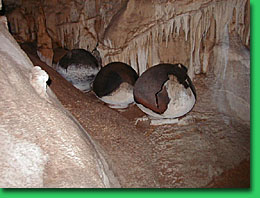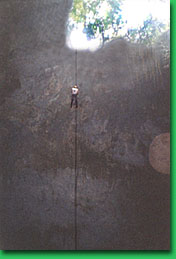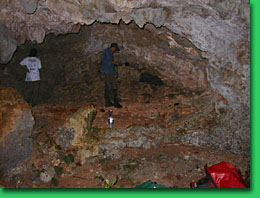
 |
 |

Kids' Update Part 2 by Bruce Minkin

 ave you ever wondered what it would be like to find evidence of an ancient culture in a cave? Or how about hacking through the jungle and discovering a temple hidden in the vines?
ave you ever wondered what it would be like to find evidence of an ancient culture in a cave? Or how about hacking through the jungle and discovering a temple hidden in the vines?
I had the thrill of being the first person in our group to see 1,000-year-old Maya artifacts hidden in a cave we found!

It's important for scientists to get to these places before looters steal what is inside. The looters are the bad guys; they illegally remove and sell the artifacts. This ruins the scientific value, because we can't tell much about their use or meaning if they are moved or damaged. The good guys are the archaeologists, scientists that study ancient cultures by what the people left behind.
Caves were sacred places for the ancient Maya. They took special offerings like pottery, tools, and food into the caverns. They hoped that these gifts to the gods would improve their crops and make their lives better.
|  |
Radar from airplanes helped identify points in the jungle that might be caves. Then using GPS satellite messages for positions, we hiked through the jungle to the caves.
 |
Some of the caves had entrances that were vertical pits called sinkholes. To get to the bottom we had to slide down a rope. This method is called rappeling. We use special seat harnesses, metal rings or carabiners, and a rack to control our descent. To get back up was a lot harder. We use ascenders, clamps on foot and chest, to walk back up the rope. |
We found one cave that had a drop of over 100 ft. The chamber inside was bigger than a basketball stadium. The Maya hid beautiful pottery and stone tools inside. How they got into this huge cave is a mystery.

 hile we hiked through the jungle, William showed us many unusual plants and animals. He grew up in the woods and know a lot about the old ways of the Maya. It was a lot like walking through a drug store. He stopped to show us a copal tree. The ancient Maya burned its sap as incense. The berries could be squished and the juice used as an insect repellant. It smells just like Off! bug spray.
hile we hiked through the jungle, William showed us many unusual plants and animals. He grew up in the woods and know a lot about the old ways of the Maya. It was a lot like walking through a drug store. He stopped to show us a copal tree. The ancient Maya burned its sap as incense. The berries could be squished and the juice used as an insect repellant. It smells just like Off! bug spray.
He pulled up a small shrub with blue flowers. It was a Vicks plant, after Vicks Vapo rub. The roots smelled just like the medicine. The local people boil it to breathe in the steam and clear up colds. William also showed us a plant with a white worm-like flower. The Maya boil the flowers and make a tea to treat intestinal worms. They say it works well!
If you listen patiently, the sounds of the jungle are amazing. William pointed out the distinctive sound of a toucan flying by and the sound of a hummingbird when it buzzes around your head. One night I even heard a puma, or mountain lion. The next day William pointed out the tracks, and he saw it with his headlight during the evening.
The butterflies in the jungle are amazing. Because everything is green, they need to stand out to attract a mate. When the owl-eye butterfly's wings are open, they display beautiful shiny blue and orange stripes. When the wings are closed, the camouflage markings hide it from predators. |  |
One day we stopped by the Chaa Creek Nature Preserve. They raise blue morpheus butterflies for export. I brought back butterfly pupae for the kids' classes in Asheville. They watched the beautiful blue butterflies emerge from their cocoons and fly around for weeks! Because they are raised commercially, it doesn't harm the local population of butterflies.

 t's important that the world preserves the rain forests for many reasons. If development destroys the forest, we will lose wonderful creatures. Also, many of the medicines we use now come from the rain forest. There's no telling how many miracle cures are waiting to be discovered! Finally, if archeologists can help save the forests, we will also have amazing Maya temples and caves to study in the future!
t's important that the world preserves the rain forests for many reasons. If development destroys the forest, we will lose wonderful creatures. Also, many of the medicines we use now come from the rain forest. There's no telling how many miracle cures are waiting to be discovered! Finally, if archeologists can help save the forests, we will also have amazing Maya temples and caves to study in the future!
CLICK HERE FOR THE PREVIOUS UPDATE!
This update is dedicated to Alex Minkin, Sam Warner, and their fellow students in Asheville, North Carolina, and Debbie Szymanski and her students, also in Asheville. |
 he mission of our team of archaeologists was to find new caves and study the artifacts we found there. Our base camp was near the border of Belize and Guatemala. Getting there was half the fun. We loaded our gear into the trusty gray truck and picked up William, the Belizean member of our crew. His pet coatimundi greeted us by scampering up our legs and searching for a hand out. (
he mission of our team of archaeologists was to find new caves and study the artifacts we found there. Our base camp was near the border of Belize and Guatemala. Getting there was half the fun. We loaded our gear into the trusty gray truck and picked up William, the Belizean member of our crew. His pet coatimundi greeted us by scampering up our legs and searching for a hand out. (